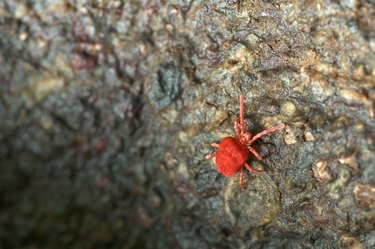
In the same way that red lights warn drivers and pedestrians, the color red in nature is a warning signal to predators. Whether it's an instinctive or learned behavior, animals associate red with causing pain or tasting awful. It seems to work with humans too because finding little red bugs all over your backyard can be really disconcerting. Don't reach for the bug fogger (or call a pest control service) too quickly, though. Some of those creatures might be helping your garden, so properly identifying which bug you're dealing with is essential before you make treatment decisions.
The Good Guys: Red Velvet Mites
Video of the Day
Those little red bugs in your backyard might not technically be bugs at all. Related to spiders and other arachnids, red velvet mites (Trombidiidae spp.) are less than 1/4 in. long with a bright red, plush-appearing body.
Video of the Day
There is no need to get rid of these creatures. Rather, in fact, there's a strong argument for letting them survive and flourish. They are harmless to you and your pets, and like their spider cousins, they feed on pest insects that might be damaging your plants, like beetles, grasshoppers and plant hoppers. If you aren't sure that you can differentiate between red velvet mites and various other tiny red bugs that might crop up in your garden, you can usually take specimens to your local extension service for identification. It's not a bad idea to do that before calling in pest control people.
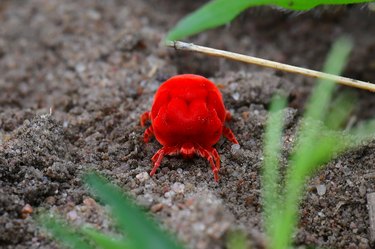
Recognizing & Deterring Clover Mites
The red clover mite (Bryobia praetiosa) is approximately 1/32 in. long and is distinguished from other red mites by its long front legs. Clover mites are common plant-feeding backyard and indoor pests, particularly after rain in spring. To deal with an outdoor clover mite infestation, mix 2 Tbsp. liquid dish soap and 1 gallon water into a garden sprayer. Spray over the infested area and repeat application as necessary.
Prevent clover mites from becoming a problem indoors by removing "mite bridges" from your yard to your building. These include plants, landscaping stones, debris or anything else that physically provides a pathway from the yard to your home. Pay especially close attention to pathways that coincide with entry points to your home, like shrubs alongside a doorway or branches grazing a windowsill. Another tactic is to loosen soil in a strip up to 24 in. wide around your house; clover mites avoid crossing cultivated soil.

Recognizing & Deterring Harvest Mites
If you or your pets experience itchy, swollen welts after spending time in the backyard, the little red creatures responsible might be harvest mites (Trombicula alfreddugesi), also called chiggers. At 1/64 to 1/20 in. long, these eight-legged creatures are barely visible to the naked eye. As adults, they're harmless and don't bite humans. However, their six-legged larvae are notable nuisance pests because they inject digestive enzymes into human and animal skin and then feed on affected cells. (And yes, that's exactly as unpleasant as it sounds!)
Chiggers can remain attached to skin for several days or until you scrub them off with hot, soapy water. To prevent bites, wear protective clothing and insect repellent containing DEET. To reduce or eliminate chiggers in the yard without resorting to commercial insecticide, clear away brush piles, prune bushes and mow lawns as close to the ground as possible. These methods help reduce ground level humidity, a condition favored by harvest mites.
Recognizing & Deterring Spider Mites
Spider mites (Tetranycus spp.) are very tiny like other mites (smaller than a pinhead) and may be red, green or gray depending on their species. Some are only red, red-orange or reddish-brown at specific times in their life cycle. Despite their small size, they're relatively easy to spot because they spin webs like tiny red spiders. They're happy to feed on almost any plant, so they're difficult to narrow down to a specific habitat, and you'll find them on houseplants just as often as garden plants.
Predator species are a natural control for spider mites (and provide another reason not to break out the fogger immediately). A soap-based spray is another low-impact option, though for serious infestations, you can resort to a targeted miticide. Unlike harvest mites, spider mites like dry and dusty conditions (and drought-weakened plants are especially susceptible), so irrigating regularly and dampening paths and walkways will help keep them from becoming established.
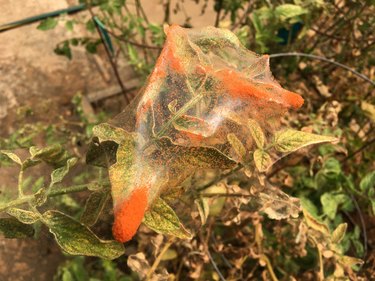
Recognizing & Deterring Boxelder Bugs
At less than 1/2 in. long, boxelder bugs (Boisea trivittata) are dark gray, elongated insects with three red lines on the area behind their head. Immature nymphs of boxelder bugs are often bright red. Both feed on shade or fruit trees and often congregate on tree trunks.
Homeowners can remove boxelder bugs with a forceful spray of water from the garden hose, repeated as often as necessary. Alternatively, use a wet-dry shop vacuum to suck up congregating bugs but be sure to add a bit of water and a few drops of liquid dish soap to the vacuum tank to kill bugs and prevent their foul odor from adhering to equipment.
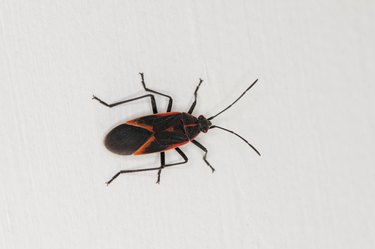
Recognizing & Deterring Red Bugs
Red bugs, or stainers, are aptly named true bugs in the family Pyrrhocoridae. The cotton stainer (Dysdercus suturellus) is the only stainer known to be native to the United States and gets its name from its habit of leaving yellowish stains on cotton bolls as it feeds on them.
However, an introduced species, the Mediterranean red bug (Scantius aegyptius) has recently arrived in California, where it is considered an invasive species. First documented in 2009, the adult insects are slightly more than 1/4 in. long with black markings on their red forewings. Nymphs are a solid bright red color and can leave red stains on affected plants. Stainers are similarly colored and may be found feeding on backyard fruit trees. Invasive red bugs congregate in large numbers and feed on a variety of plants and seeds on the ground.
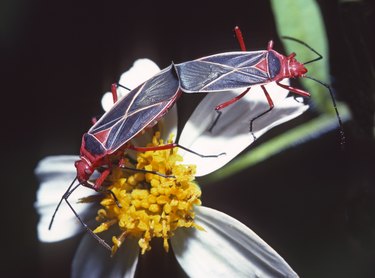
Some evidence suggests that ants may be natural predators of red bugs. For small infestations of red bugs, pick them off or knock them into a bucket of soapy water. You can also use small piles of seeds or fruit as bait to attract insects to one area and then kill them with soapy or hot water. Tanglefoot will keep stainers from climbing trees to attack fruit.